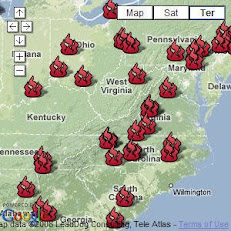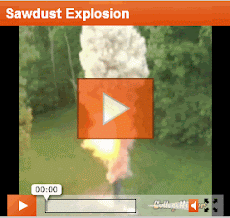
According to media accounts over the last six months since the Imperial Sugar Refinery sugar dust explosion over 80 combustible dust related fires and explosions have occurred in the United States in the nations' manufacturing sector. Many incidents are not reported to the media, so the fires and explosions that are reported are only a small sampling of events in the manufacturing sector.
The Combustible Dust Policy Institute at the research facility in Santa Fe, Texas has discovered that over 30% of the incidents are repeats of combustible dust fires and explosions. Incidents reoccur because the initial fire or explosion is not reported to enforcement and regulatory agencies unless fatalities or numerous injuries result from the incident. As a result, proactive preventive and mitigative measures, which minimize the occurrence and reduce the severity of future incidents are not implemented.
Since February 7, 2008, wood dust is the leading material involved in combustible dust incidents, followed by metal (17%), food (14%), and paper (12%). The Chemical Safety Board Dust Hazard study did not take into account combustible dust fires and explosions caused by paper or textile dust. Additionally, the OSHA Combustible Dust National Emphasis Program (NEP) does not recognize paper as a material involved in industries that may have potential for combustible dust explosions/fires or have more frequent and/or high consequence combustible dust explosions/fires. The current incident rate over the last six months paints a different story, with paper combustible dust the fourth leading material causing fires or explosions.
Utilizing the 2006 CSB Dust Hazard study as the sole indicator of materials that are the cause of incidents can be misleading. For example the CSB listed only 281 incidents for the 1980-2005 period, when the correct amount should be over 3,500 incidents. Since the incidents in the Dust Hazard Study were less than a 10% sampling, all the other metrics such as specific industries and materials involved in incidents are severly skewed and distorted representing a false picture. This could present a problem for stakeholders conducting a process hazard analysis of their facilities, believing that incidents don't occur in their specific industry group when they really do.
On the other side of the coin, since the CSB data is incorrect, industries were reported with a high incident rates when they are not. For example, over the last six months materials involving food products account for 14% of incidents. In contrast, the CSB report states that materials involving food are the leading cause of combustible dust fire and explosions at over 23%. Currently wood (33%) and metal (17%) materials are the leading cause of combustible dust incidents.
The CSB Dust Hazard Study is an excellent resource in understanding how combustible dust fires and explosions occur. Additionally the report highlights key areas that should be addressed in preventing future incidents. Hopefully in the future, a reporting system will develop utilizing Internet technology so all stakeholders can grasp the extent of the problem and take appropiate measures in the prevention and mitigation of future incidents







